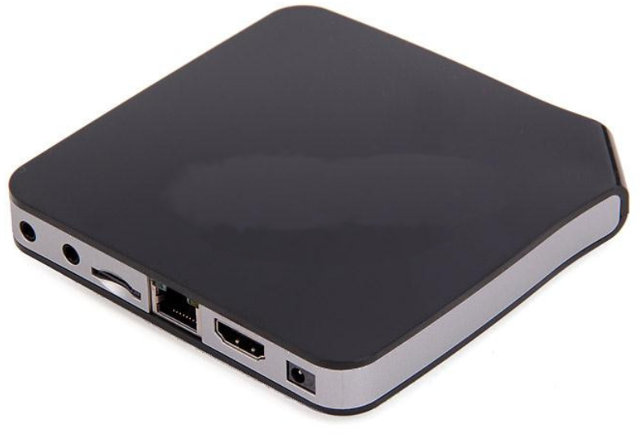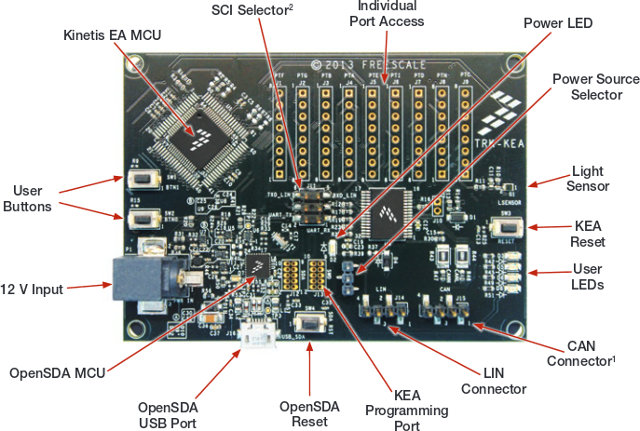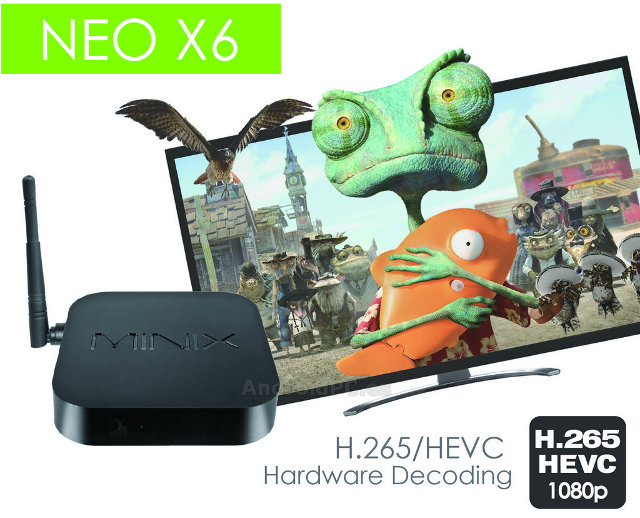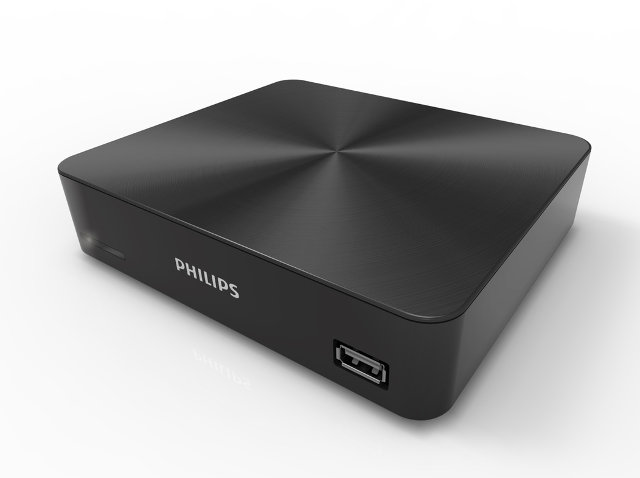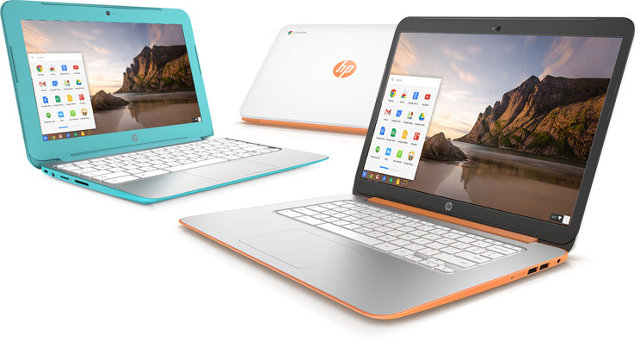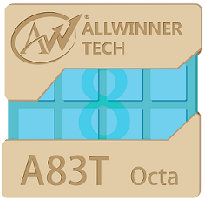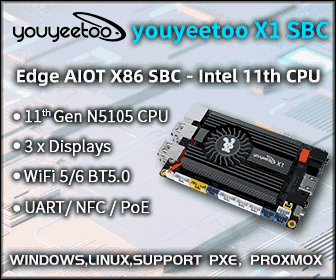Yesterday I wrote about MINIX NEO X6 featuring Amlogic S805 quad core Cortex A5 processor with HEVC hardware decoding. MINIX device is expected to sell later this month for around $120, but I’ve been informed there’s another model called TV110 with similar hardware specifications, but selling for around $60 or even lower on sites like GeekBuying and Aliexpress. I’ve seen one of the seller offering $10 coupon, so it might even be possible to get it for $50. TV110-S805 specifications: SoC – Amlogic S805 quad core ARM Cortex A5 @ 1.5GHz with quad core Mali-450MP GPU System Memory – 1 GB DDR3 Storage – 8 GB NAND flash + micro SD slot Connectivity – 10/100M Ethernet, 802.11 b/g/n Wi-Fi (2.4 GHz), Bluetooth 4.0 Video Output – HDMI 1.4, AV output Audio Output – HDMI 1.4, 3.5mm stereo audio jack USB – 2x USB 2.0 port Misc – IR sensor Power […]
Freescale To Give Away StarterTRAK Development Boards for Automotive Applications
Freescale StarterTRAK development boards are based on the company’s Kinetis EA Cortex M0+ MUCs or Qorivva 32-bit MCU targeting automotive applications with support a wide temperature range (–40° to +125°C) and interfaces such as LIN (Local Interconnect Network) and CAN. These development boards can be used for body and security, powertrain, and safety & chassis applications. Freescale has decided to giveaway 60 StarterTRACK development board to random winners, so if you are knowledgeable in this field it could be an opportunity to try the platform. There will be 5 different kits given away, all based on Kinetis MCU: TRK‐KEA8, TRK‐KEA64, TRK‐KEA128, KEA128LEDLIGHTRD and KEA128BLDCRD. Let’s have a closer look at TRK-KEA128 development board. Key features and specifications of TRK-KEA128 board: MCU – Kinetis KEA128 ARM Cortex M0+ MCU @ 48MHz with 16KB RAM and 128KB flash in a 80 LQFP package On-board openSDA debugging and programming circuit using the PK20DX128 MCU […]
MINIX NEO X6 Features Amlogic S805 Processor with Full HD HEVC Support
Amlogic S805 is a cost down version of the popular Amlogic S802. It features four Cortex A5 cores, and quad core Mali450-MP GPU, only support 1080p resolution (no 4K), but adds hardware decoding for HEVC / H.265 at 1080p resolution, which is not possible with his big brother. In theory, I should also support Gigabit Ethernet, but none of the upcoming media players support it, allegedly because it’s not working yet… After products by the likes of Ugoos, Eny Technology. and Geniatech, it’s time for MINIX to announce their own S805 mini PC with the NEO X6. NEO X6 Specifications: SoC – Amlogic S805 quad core ARM Cortex A5 @ 1.5GHz with quad core Mali-450MP4 GPU System Memory – 1 GB DDR3L Storage – 8 GB eMMC + micro SD slot Connectivity – 10/100M Ethernet, 802.11 b/g/n Wi-Fi (2.4 GHz) with external antenna, Bluetooth 4.0 Video Output – HDMI 1.4 […]
TP Vision Announces Philips UHD 880 Media Player Running Android L for Philips UHD Televisions
TV Vision has unveiled a new 4K media player to bring HEVC streaming capabilities to Philips UHD TVs at IFA 2014 in Berlin. The device will be based on Android L, and is said to be compatible with all 2013 and 2014 Philips UHD TVs. It should be compatible with other 4K TVs as well, but they mention some limitations due to HDCP, and some 2013 Philips TV will only handle 4K at 30 fps. Another interesting point is that if you have bought a recent Philips UHD TV, this media player may be free of charge. The specs are not complete, but here’s what we know: SoC – N/A System Memory – N/A Storage – 12GB storage to install apps (So most probably a 16GB eMMC or NAND flash) Video Output – HDMI 2.0 with HDCP 1.4, HDCP 2.2 support Main Video Codecs and Containers – HEVC (up to […]
The New HP Chromebook 14 Features Nvidia Tegra K1 SoC
With HP SlateBook 14, Hewlett Packard already had a Tegra (4) based notebook with a 14″ display, but running Android 4.3, which may not be the best OS on such device. The company has now announced their new Chromebook 14 featuring an Nvidia Tegra K1 processor, 2 to 4GB RAM, and 16GB eMMC or 32GB M.2 SSD. The previous version of HP Chromebook 14 was based on Intel Celeron 2955U. HP Chromebook 14 specifications: SoC- Nvidia Tegra K1 quad core Cortex A15 processor with Kepler GK20A GPU System Memory – 2 to 4 GB DDR3L @ 1600MHz depending on model Storage – 16GB eMMC, or 32 GB M.2 SSD, and 100GB Google Drive Storage Display – 14″ display (1080p according to press release, 1366×768 according to product page). Video Output – HDMI Audio – 3.5mm headphone-out/microphone-in combo jack Camera – HD webcam with integrated microphone Connectivity – 802.11 b/n/g/ac Wi-Fi […]
AllWinner Announces A83T Octa Core Processor for Tablets
So Allwinner has just announced a new processor. I’ve been disappointed recently when I discovered AllWinner A80 only supports Linux 3.4, whereas most competitors are running Android 3.10 stable kernel, and their partner is distributing A80 OptimusBoard development boards, which looks to be a nice hardware platform, but without any Android or Linux SDK… And with their latest press release you have to wonder… They announced AllWinner A83T processor with “eight highly energy-efficient Cortex-A7 cores that could run simultaneously at around 2.0GHz, and implements the advanced big.LITTLE architecture to maximize the battery life”. The only problem is that with big.LITTLE you need big and LITTLE core, and if AllWinner A83T is just having eight Cortex A7 cores, there’s no big to be found… I guess that just means they can turn cores on and off independently… Allwinner must also have adopted Qualcomm or Mediatek press release “strategy”, as they release […]
iControlHub is An Upcoming XBMC Media Center Powered by Intel Celeron J1900 Processor
Earlier this week, we’ve seen MINIX NEO Z64 mini PC based on Intel Atom Z3735F that will sell for less than $150 in October. If you’d like a low power low cost Intel based fanless mini PC but with a bit more processing power, iControlHub could be an option with an Intel Celeron J1900 Bay Trail quad core processor. Preliminary specifications for iControlHub: SoC – Intel Celeron J1900 processor @ 2.0 GHz (Burst frequency 2.41 GHz) with Intel HD graphics (Max TDP) System Memory – Up to 8GB DDR3 Storage – HDD / SSD via mSATA connector Video Output – HDMI Audio Output – HDMI, optical S/PDIF Connectivity – Gigabit Ethernet, Wi-Fi with two external antennas USB – 2x USB 2.0 host ports, 1x USB 3.0 host port Misc – IR in and out Power Supply – 12V Dimensions – 125 x 125 mm (Board) You must be confused with […]
Samsung Unveils Galaxy Note 4 and Note Edge with Curved Display
IFA 2014 tradeshow is just starting today, and will last until the 9th of September, but several companies have made announcements just before the show. One of them is Samsung which announced Gear VR virtual reality kit, Tizen based Gear S smartwatch, as well as two new smarthones, Galaxy Note 4 and Note Edge, which will be the subject of this post. Samsung Galaxy Note Edge Galaxy Note Edge is much different from most other phones thanks to its curved display on one side of the phone. Other specifications: SoC – Qualcomm Snapdragon S805 quad core Krait 400 processor @ 2.7 GHz with Adreno 420 GPU System Memory – 3GB RAM Storage – 32 or 64 GB internal memory + micro SD slot (up to 64GB) Display – 5.6″ Quad HD+ Super AMOLED (2560 x 1440 + 160) Cellular Networking: 2.5G (GSM/ GPRS/ EDGE): 850 / 900 / 1800 / […]


